Violence in Boys: Ingrained or Cultivated?
VerifiedAdded on 2023/06/13
|8
|2034
|74
AI Summary
This article explores the factors that contribute to violence in boys and whether it is ingrained or cultivated. It discusses the impact of environment, culture, media, and masculinity on boys' violent behavior.
Contribute Materials
Your contribution can guide someone’s learning journey. Share your
documents today.

Running head: VIOLENCE IN BOYS, INGRAINED OR CULTIVATED?
VIOLENCE IN BOYS, INGRAINED OR CULTIVATED?
VIOLENCE IN BOYS, INGRAINED OR CULTIVATED?
Secure Best Marks with AI Grader
Need help grading? Try our AI Grader for instant feedback on your assignments.
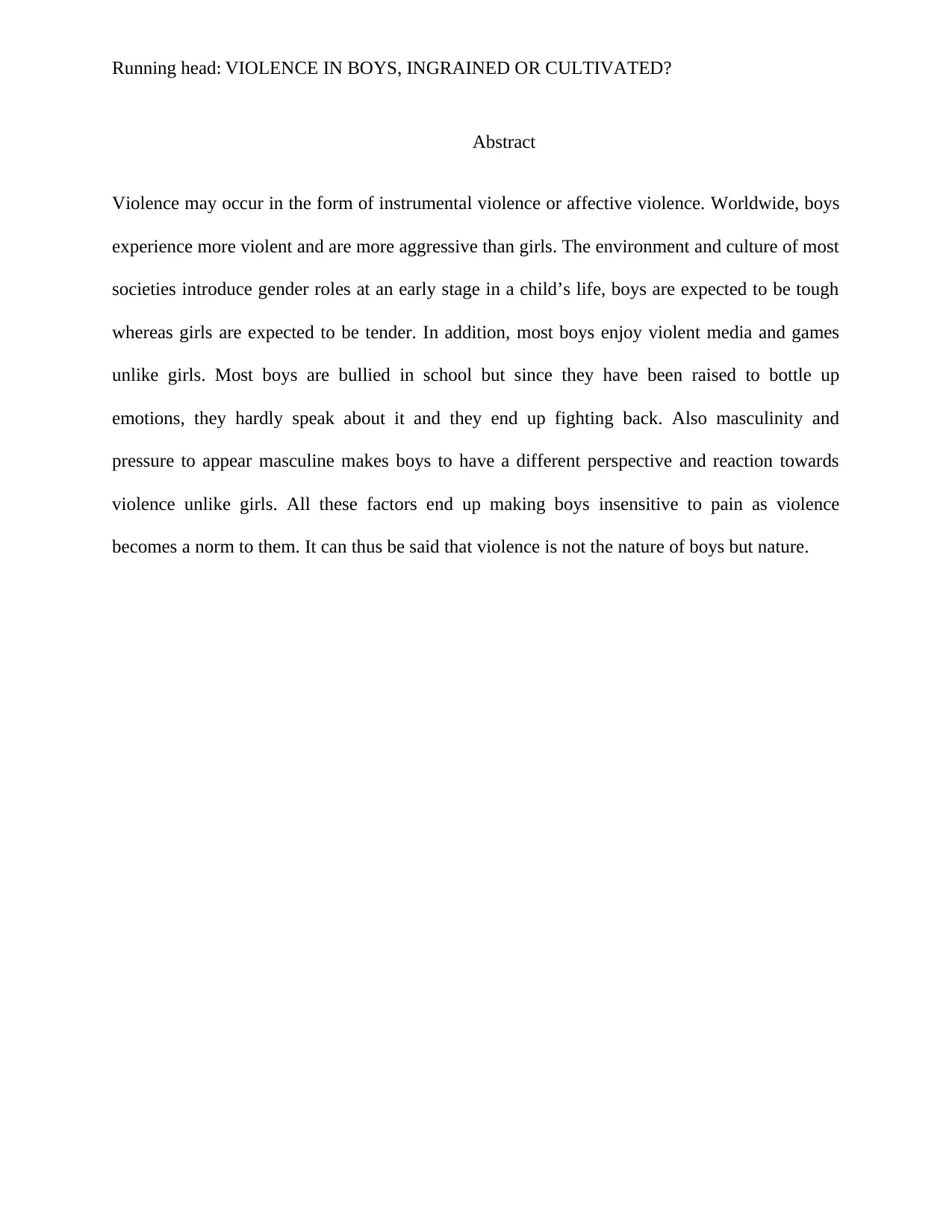
Running head: VIOLENCE IN BOYS, INGRAINED OR CULTIVATED?
Abstract
Violence may occur in the form of instrumental violence or affective violence. Worldwide, boys
experience more violent and are more aggressive than girls. The environment and culture of most
societies introduce gender roles at an early stage in a child’s life, boys are expected to be tough
whereas girls are expected to be tender. In addition, most boys enjoy violent media and games
unlike girls. Most boys are bullied in school but since they have been raised to bottle up
emotions, they hardly speak about it and they end up fighting back. Also masculinity and
pressure to appear masculine makes boys to have a different perspective and reaction towards
violence unlike girls. All these factors end up making boys insensitive to pain as violence
becomes a norm to them. It can thus be said that violence is not the nature of boys but nature.
Abstract
Violence may occur in the form of instrumental violence or affective violence. Worldwide, boys
experience more violent and are more aggressive than girls. The environment and culture of most
societies introduce gender roles at an early stage in a child’s life, boys are expected to be tough
whereas girls are expected to be tender. In addition, most boys enjoy violent media and games
unlike girls. Most boys are bullied in school but since they have been raised to bottle up
emotions, they hardly speak about it and they end up fighting back. Also masculinity and
pressure to appear masculine makes boys to have a different perspective and reaction towards
violence unlike girls. All these factors end up making boys insensitive to pain as violence
becomes a norm to them. It can thus be said that violence is not the nature of boys but nature.
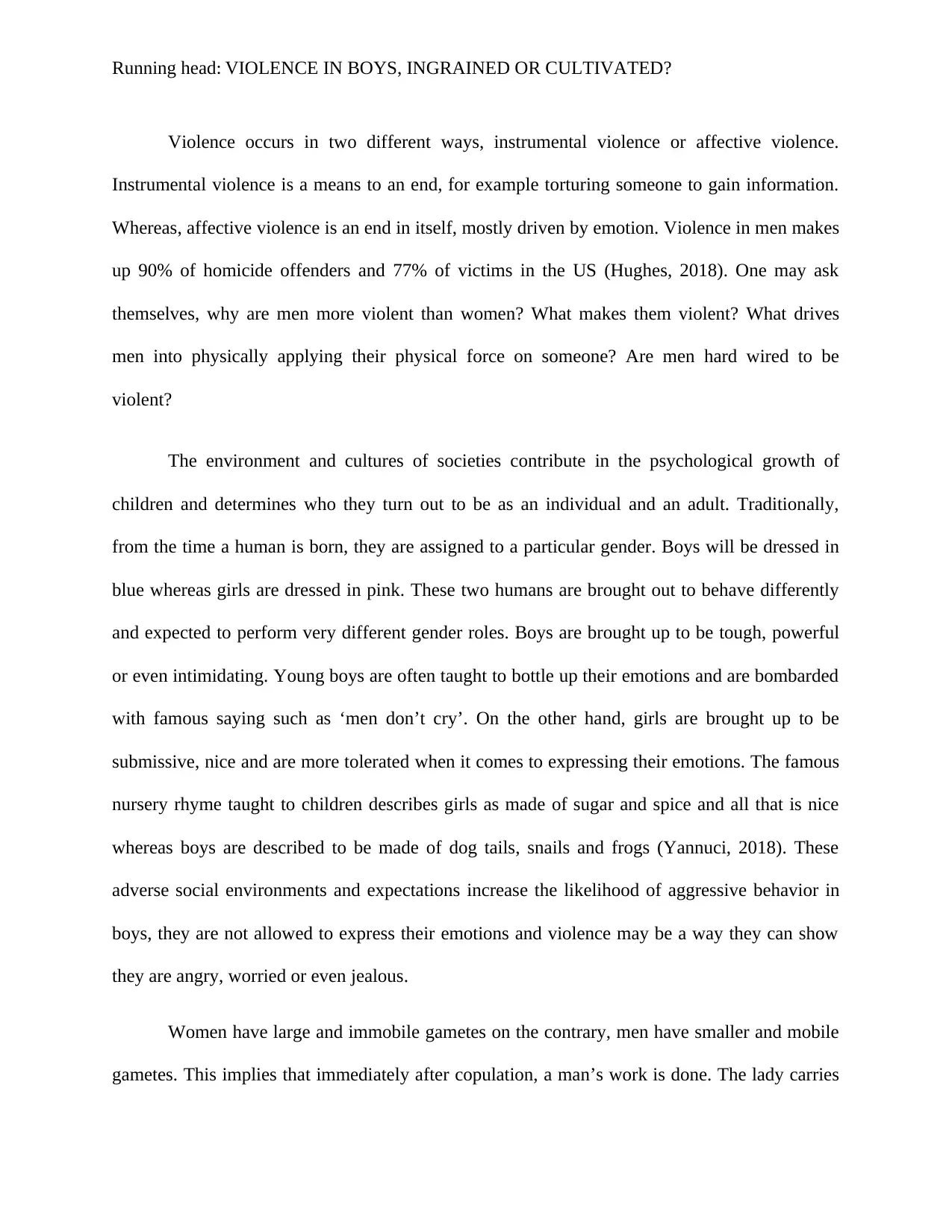
Running head: VIOLENCE IN BOYS, INGRAINED OR CULTIVATED?
Violence occurs in two different ways, instrumental violence or affective violence.
Instrumental violence is a means to an end, for example torturing someone to gain information.
Whereas, affective violence is an end in itself, mostly driven by emotion. Violence in men makes
up 90% of homicide offenders and 77% of victims in the US (Hughes, 2018). One may ask
themselves, why are men more violent than women? What makes them violent? What drives
men into physically applying their physical force on someone? Are men hard wired to be
violent?
The environment and cultures of societies contribute in the psychological growth of
children and determines who they turn out to be as an individual and an adult. Traditionally,
from the time a human is born, they are assigned to a particular gender. Boys will be dressed in
blue whereas girls are dressed in pink. These two humans are brought out to behave differently
and expected to perform very different gender roles. Boys are brought up to be tough, powerful
or even intimidating. Young boys are often taught to bottle up their emotions and are bombarded
with famous saying such as ‘men don’t cry’. On the other hand, girls are brought up to be
submissive, nice and are more tolerated when it comes to expressing their emotions. The famous
nursery rhyme taught to children describes girls as made of sugar and spice and all that is nice
whereas boys are described to be made of dog tails, snails and frogs (Yannuci, 2018). These
adverse social environments and expectations increase the likelihood of aggressive behavior in
boys, they are not allowed to express their emotions and violence may be a way they can show
they are angry, worried or even jealous.
Women have large and immobile gametes on the contrary, men have smaller and mobile
gametes. This implies that immediately after copulation, a man’s work is done. The lady carries
Violence occurs in two different ways, instrumental violence or affective violence.
Instrumental violence is a means to an end, for example torturing someone to gain information.
Whereas, affective violence is an end in itself, mostly driven by emotion. Violence in men makes
up 90% of homicide offenders and 77% of victims in the US (Hughes, 2018). One may ask
themselves, why are men more violent than women? What makes them violent? What drives
men into physically applying their physical force on someone? Are men hard wired to be
violent?
The environment and cultures of societies contribute in the psychological growth of
children and determines who they turn out to be as an individual and an adult. Traditionally,
from the time a human is born, they are assigned to a particular gender. Boys will be dressed in
blue whereas girls are dressed in pink. These two humans are brought out to behave differently
and expected to perform very different gender roles. Boys are brought up to be tough, powerful
or even intimidating. Young boys are often taught to bottle up their emotions and are bombarded
with famous saying such as ‘men don’t cry’. On the other hand, girls are brought up to be
submissive, nice and are more tolerated when it comes to expressing their emotions. The famous
nursery rhyme taught to children describes girls as made of sugar and spice and all that is nice
whereas boys are described to be made of dog tails, snails and frogs (Yannuci, 2018). These
adverse social environments and expectations increase the likelihood of aggressive behavior in
boys, they are not allowed to express their emotions and violence may be a way they can show
they are angry, worried or even jealous.
Women have large and immobile gametes on the contrary, men have smaller and mobile
gametes. This implies that immediately after copulation, a man’s work is done. The lady carries
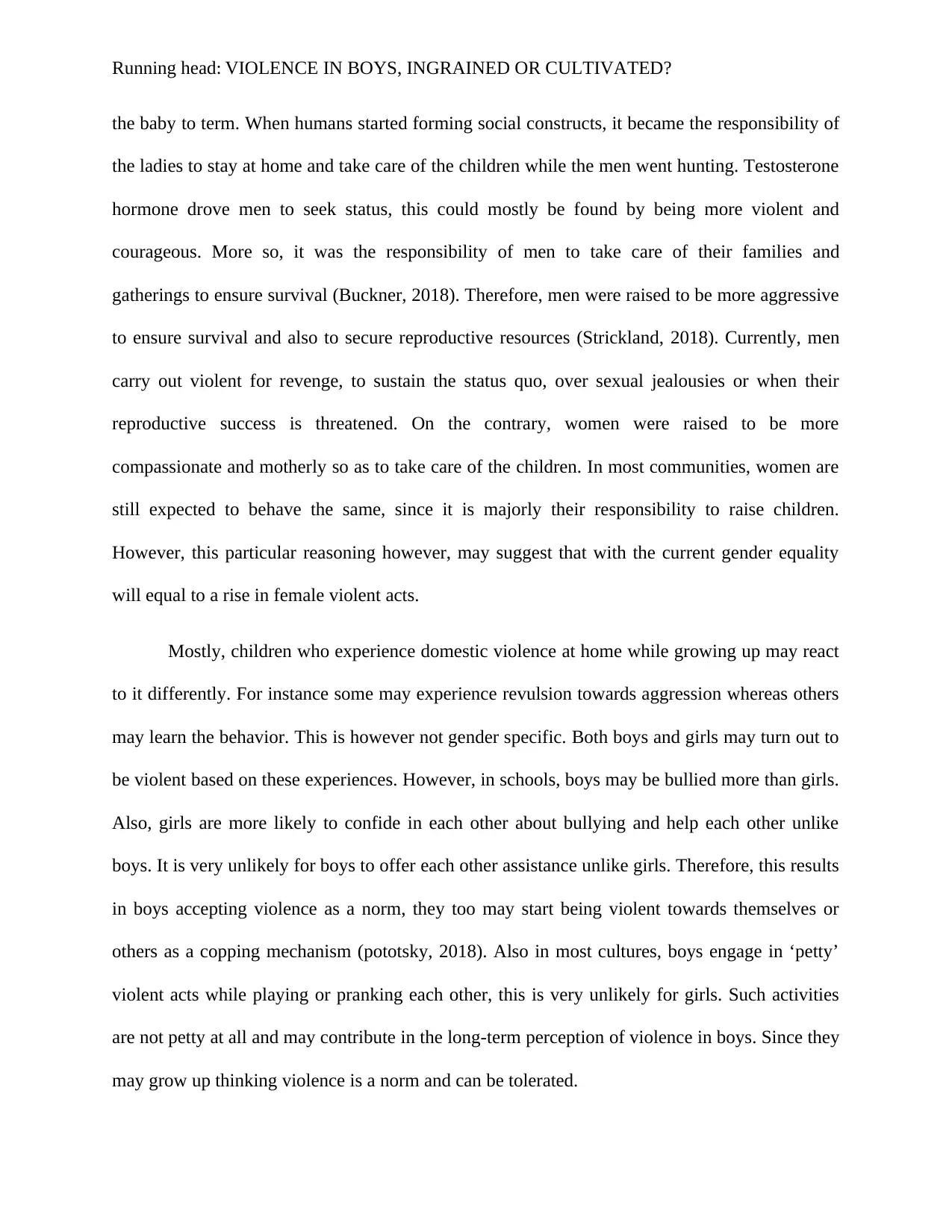
Running head: VIOLENCE IN BOYS, INGRAINED OR CULTIVATED?
the baby to term. When humans started forming social constructs, it became the responsibility of
the ladies to stay at home and take care of the children while the men went hunting. Testosterone
hormone drove men to seek status, this could mostly be found by being more violent and
courageous. More so, it was the responsibility of men to take care of their families and
gatherings to ensure survival (Buckner, 2018). Therefore, men were raised to be more aggressive
to ensure survival and also to secure reproductive resources (Strickland, 2018). Currently, men
carry out violent for revenge, to sustain the status quo, over sexual jealousies or when their
reproductive success is threatened. On the contrary, women were raised to be more
compassionate and motherly so as to take care of the children. In most communities, women are
still expected to behave the same, since it is majorly their responsibility to raise children.
However, this particular reasoning however, may suggest that with the current gender equality
will equal to a rise in female violent acts.
Mostly, children who experience domestic violence at home while growing up may react
to it differently. For instance some may experience revulsion towards aggression whereas others
may learn the behavior. This is however not gender specific. Both boys and girls may turn out to
be violent based on these experiences. However, in schools, boys may be bullied more than girls.
Also, girls are more likely to confide in each other about bullying and help each other unlike
boys. It is very unlikely for boys to offer each other assistance unlike girls. Therefore, this results
in boys accepting violence as a norm, they too may start being violent towards themselves or
others as a copping mechanism (pototsky, 2018). Also in most cultures, boys engage in ‘petty’
violent acts while playing or pranking each other, this is very unlikely for girls. Such activities
are not petty at all and may contribute in the long-term perception of violence in boys. Since they
may grow up thinking violence is a norm and can be tolerated.
the baby to term. When humans started forming social constructs, it became the responsibility of
the ladies to stay at home and take care of the children while the men went hunting. Testosterone
hormone drove men to seek status, this could mostly be found by being more violent and
courageous. More so, it was the responsibility of men to take care of their families and
gatherings to ensure survival (Buckner, 2018). Therefore, men were raised to be more aggressive
to ensure survival and also to secure reproductive resources (Strickland, 2018). Currently, men
carry out violent for revenge, to sustain the status quo, over sexual jealousies or when their
reproductive success is threatened. On the contrary, women were raised to be more
compassionate and motherly so as to take care of the children. In most communities, women are
still expected to behave the same, since it is majorly their responsibility to raise children.
However, this particular reasoning however, may suggest that with the current gender equality
will equal to a rise in female violent acts.
Mostly, children who experience domestic violence at home while growing up may react
to it differently. For instance some may experience revulsion towards aggression whereas others
may learn the behavior. This is however not gender specific. Both boys and girls may turn out to
be violent based on these experiences. However, in schools, boys may be bullied more than girls.
Also, girls are more likely to confide in each other about bullying and help each other unlike
boys. It is very unlikely for boys to offer each other assistance unlike girls. Therefore, this results
in boys accepting violence as a norm, they too may start being violent towards themselves or
others as a copping mechanism (pototsky, 2018). Also in most cultures, boys engage in ‘petty’
violent acts while playing or pranking each other, this is very unlikely for girls. Such activities
are not petty at all and may contribute in the long-term perception of violence in boys. Since they
may grow up thinking violence is a norm and can be tolerated.
Secure Best Marks with AI Grader
Need help grading? Try our AI Grader for instant feedback on your assignments.
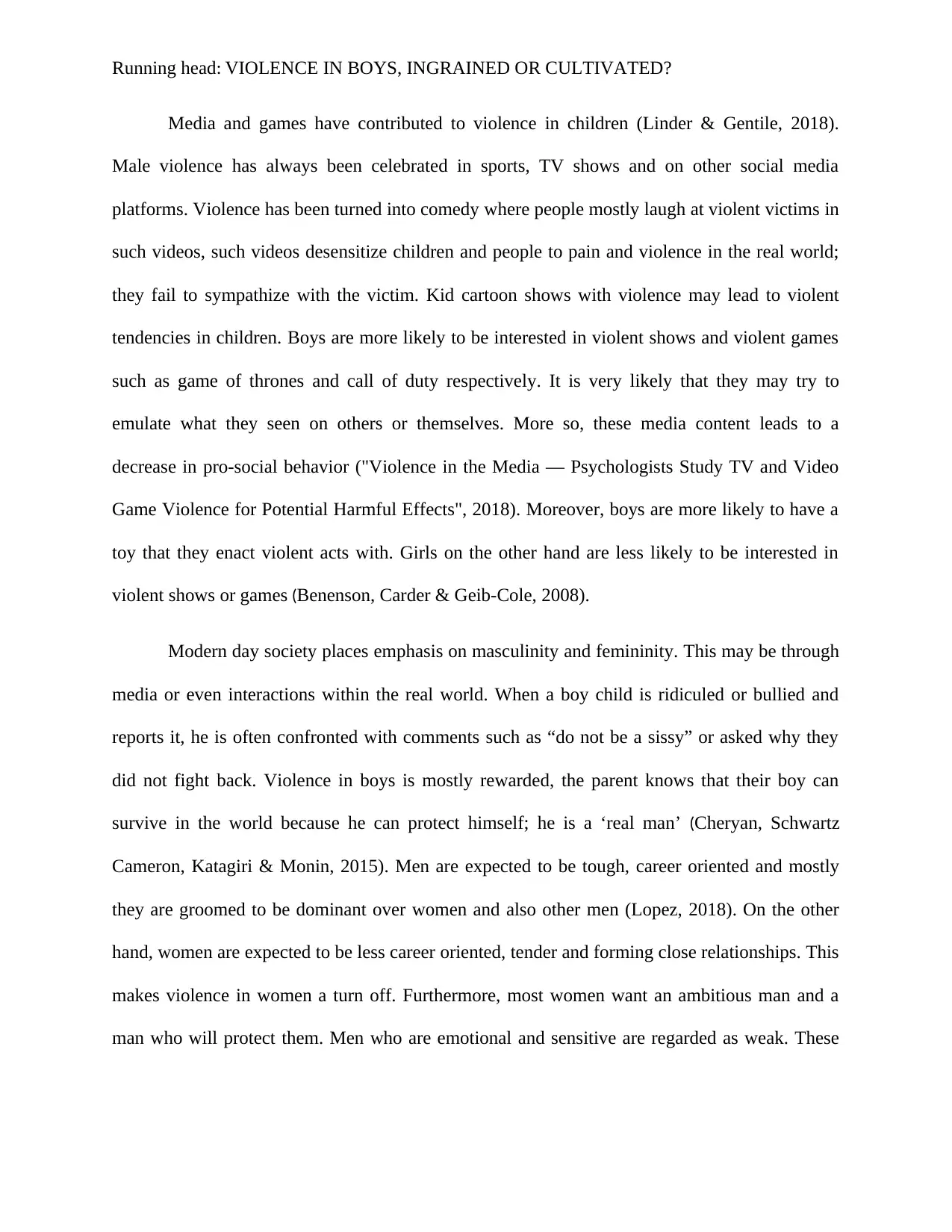
Running head: VIOLENCE IN BOYS, INGRAINED OR CULTIVATED?
Media and games have contributed to violence in children (Linder & Gentile, 2018).
Male violence has always been celebrated in sports, TV shows and on other social media
platforms. Violence has been turned into comedy where people mostly laugh at violent victims in
such videos, such videos desensitize children and people to pain and violence in the real world;
they fail to sympathize with the victim. Kid cartoon shows with violence may lead to violent
tendencies in children. Boys are more likely to be interested in violent shows and violent games
such as game of thrones and call of duty respectively. It is very likely that they may try to
emulate what they seen on others or themselves. More so, these media content leads to a
decrease in pro-social behavior ("Violence in the Media — Psychologists Study TV and Video
Game Violence for Potential Harmful Effects", 2018). Moreover, boys are more likely to have a
toy that they enact violent acts with. Girls on the other hand are less likely to be interested in
violent shows or games (Benenson, Carder & Geib-Cole, 2008).
Modern day society places emphasis on masculinity and femininity. This may be through
media or even interactions within the real world. When a boy child is ridiculed or bullied and
reports it, he is often confronted with comments such as “do not be a sissy” or asked why they
did not fight back. Violence in boys is mostly rewarded, the parent knows that their boy can
survive in the world because he can protect himself; he is a ‘real man’ (Cheryan, Schwartz
Cameron, Katagiri & Monin, 2015). Men are expected to be tough, career oriented and mostly
they are groomed to be dominant over women and also other men (Lopez, 2018). On the other
hand, women are expected to be less career oriented, tender and forming close relationships. This
makes violence in women a turn off. Furthermore, most women want an ambitious man and a
man who will protect them. Men who are emotional and sensitive are regarded as weak. These
Media and games have contributed to violence in children (Linder & Gentile, 2018).
Male violence has always been celebrated in sports, TV shows and on other social media
platforms. Violence has been turned into comedy where people mostly laugh at violent victims in
such videos, such videos desensitize children and people to pain and violence in the real world;
they fail to sympathize with the victim. Kid cartoon shows with violence may lead to violent
tendencies in children. Boys are more likely to be interested in violent shows and violent games
such as game of thrones and call of duty respectively. It is very likely that they may try to
emulate what they seen on others or themselves. More so, these media content leads to a
decrease in pro-social behavior ("Violence in the Media — Psychologists Study TV and Video
Game Violence for Potential Harmful Effects", 2018). Moreover, boys are more likely to have a
toy that they enact violent acts with. Girls on the other hand are less likely to be interested in
violent shows or games (Benenson, Carder & Geib-Cole, 2008).
Modern day society places emphasis on masculinity and femininity. This may be through
media or even interactions within the real world. When a boy child is ridiculed or bullied and
reports it, he is often confronted with comments such as “do not be a sissy” or asked why they
did not fight back. Violence in boys is mostly rewarded, the parent knows that their boy can
survive in the world because he can protect himself; he is a ‘real man’ (Cheryan, Schwartz
Cameron, Katagiri & Monin, 2015). Men are expected to be tough, career oriented and mostly
they are groomed to be dominant over women and also other men (Lopez, 2018). On the other
hand, women are expected to be less career oriented, tender and forming close relationships. This
makes violence in women a turn off. Furthermore, most women want an ambitious man and a
man who will protect them. Men who are emotional and sensitive are regarded as weak. These

Running head: VIOLENCE IN BOYS, INGRAINED OR CULTIVATED?
definitions of what masculinity should be and what femininity should be makes the former more
positively related to violence than the latter.
In addition, the idea of masculinity planted in young boys ends up being a feeling of
entitlement to power in patriarchal communities. Men are constantly insecure of their
masculinity and when they feel that they have been “unmanned” they will often exaggerate
stereotypical markers of manliness, such as being dominating or aggressive. This is done to
regain the previous masculine status. More so, the need for men to be masculine and to ‘act like a
man’ often has boys losing close friendships. This makes them lonely and deprives them of
someone they can socially confide to. Thus, boys end up getting consumed in their own thoughts
and fears which may eventually lead to aggressive character.
In conclusion, the high percentage of violence recorded on boys does not imply that boys
are born violent. It is a mere reflection of how boys have been raised to bottle up their emotions
and channel it into anger and aggression. More so, violence is not necessarily based on gender or
sex, violence can be an ingrained behavior from experiencing childhood trauma or from viewing
violent media content. Boys are more susceptible to this because violence is positively associated
with masculinities in our societies. Boys are expected to be violent towards others for them to be
regarded as manly enough to be able to protect themselves. However, this desensitizes men from
pain and sympathy and they grow up to be equally violent. Nevertheless, statistics still put boys
as more violent than girls.
definitions of what masculinity should be and what femininity should be makes the former more
positively related to violence than the latter.
In addition, the idea of masculinity planted in young boys ends up being a feeling of
entitlement to power in patriarchal communities. Men are constantly insecure of their
masculinity and when they feel that they have been “unmanned” they will often exaggerate
stereotypical markers of manliness, such as being dominating or aggressive. This is done to
regain the previous masculine status. More so, the need for men to be masculine and to ‘act like a
man’ often has boys losing close friendships. This makes them lonely and deprives them of
someone they can socially confide to. Thus, boys end up getting consumed in their own thoughts
and fears which may eventually lead to aggressive character.
In conclusion, the high percentage of violence recorded on boys does not imply that boys
are born violent. It is a mere reflection of how boys have been raised to bottle up their emotions
and channel it into anger and aggression. More so, violence is not necessarily based on gender or
sex, violence can be an ingrained behavior from experiencing childhood trauma or from viewing
violent media content. Boys are more susceptible to this because violence is positively associated
with masculinities in our societies. Boys are expected to be violent towards others for them to be
regarded as manly enough to be able to protect themselves. However, this desensitizes men from
pain and sympathy and they grow up to be equally violent. Nevertheless, statistics still put boys
as more violent than girls.
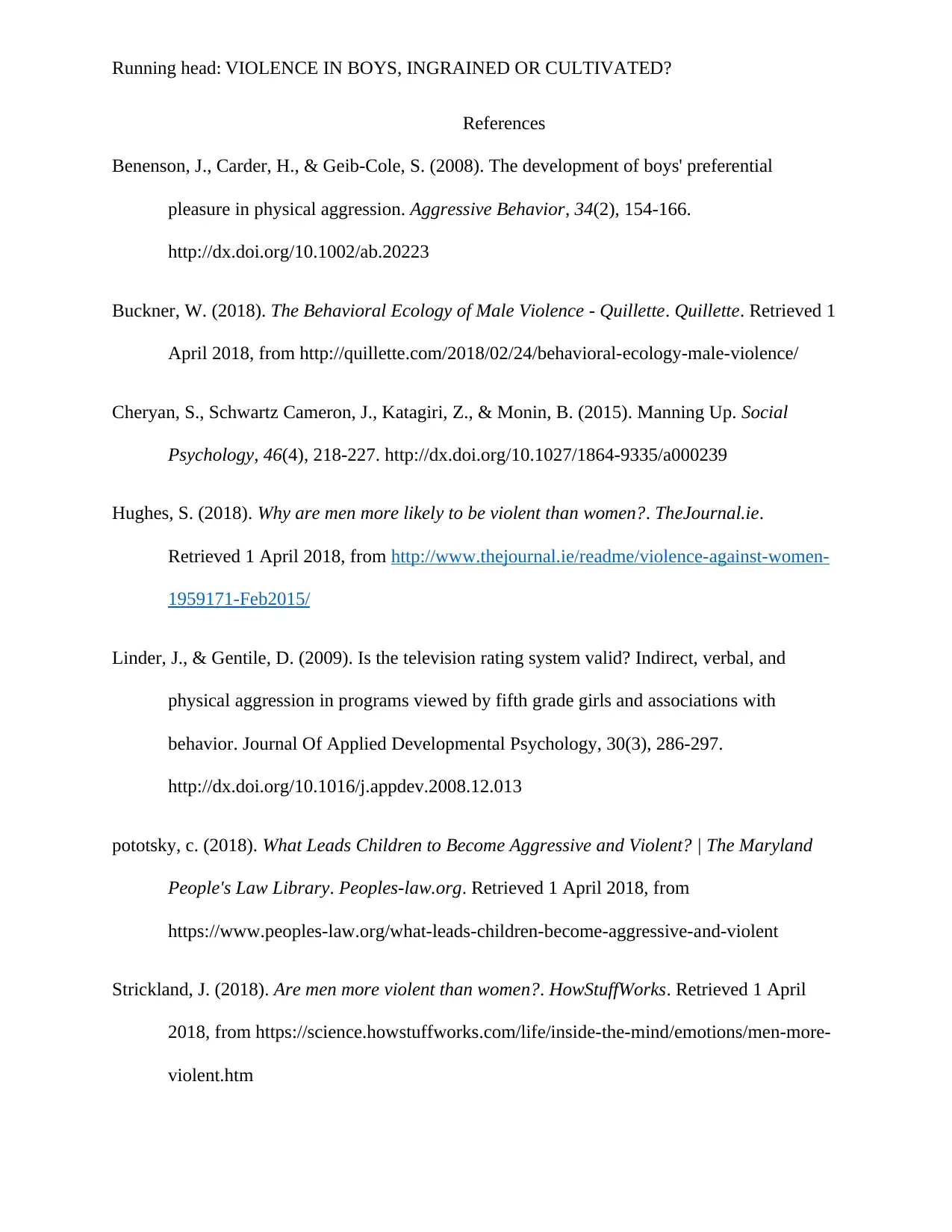
Running head: VIOLENCE IN BOYS, INGRAINED OR CULTIVATED?
References
Benenson, J., Carder, H., & Geib-Cole, S. (2008). The development of boys' preferential
pleasure in physical aggression. Aggressive Behavior, 34(2), 154-166.
http://dx.doi.org/10.1002/ab.20223
Buckner, W. (2018). The Behavioral Ecology of Male Violence - Quillette. Quillette. Retrieved 1
April 2018, from http://quillette.com/2018/02/24/behavioral-ecology-male-violence/
Cheryan, S., Schwartz Cameron, J., Katagiri, Z., & Monin, B. (2015). Manning Up. Social
Psychology, 46(4), 218-227. http://dx.doi.org/10.1027/1864-9335/a000239
Hughes, S. (2018). Why are men more likely to be violent than women?. TheJournal.ie.
Retrieved 1 April 2018, from http://www.thejournal.ie/readme/violence-against-women-
1959171-Feb2015/
Linder, J., & Gentile, D. (2009). Is the television rating system valid? Indirect, verbal, and
physical aggression in programs viewed by fifth grade girls and associations with
behavior. Journal Of Applied Developmental Psychology, 30(3), 286-297.
http://dx.doi.org/10.1016/j.appdev.2008.12.013
pototsky, c. (2018). What Leads Children to Become Aggressive and Violent? | The Maryland
People's Law Library. Peoples-law.org. Retrieved 1 April 2018, from
https://www.peoples-law.org/what-leads-children-become-aggressive-and-violent
Strickland, J. (2018). Are men more violent than women?. HowStuffWorks. Retrieved 1 April
2018, from https://science.howstuffworks.com/life/inside-the-mind/emotions/men-more-
violent.htm
References
Benenson, J., Carder, H., & Geib-Cole, S. (2008). The development of boys' preferential
pleasure in physical aggression. Aggressive Behavior, 34(2), 154-166.
http://dx.doi.org/10.1002/ab.20223
Buckner, W. (2018). The Behavioral Ecology of Male Violence - Quillette. Quillette. Retrieved 1
April 2018, from http://quillette.com/2018/02/24/behavioral-ecology-male-violence/
Cheryan, S., Schwartz Cameron, J., Katagiri, Z., & Monin, B. (2015). Manning Up. Social
Psychology, 46(4), 218-227. http://dx.doi.org/10.1027/1864-9335/a000239
Hughes, S. (2018). Why are men more likely to be violent than women?. TheJournal.ie.
Retrieved 1 April 2018, from http://www.thejournal.ie/readme/violence-against-women-
1959171-Feb2015/
Linder, J., & Gentile, D. (2009). Is the television rating system valid? Indirect, verbal, and
physical aggression in programs viewed by fifth grade girls and associations with
behavior. Journal Of Applied Developmental Psychology, 30(3), 286-297.
http://dx.doi.org/10.1016/j.appdev.2008.12.013
pototsky, c. (2018). What Leads Children to Become Aggressive and Violent? | The Maryland
People's Law Library. Peoples-law.org. Retrieved 1 April 2018, from
https://www.peoples-law.org/what-leads-children-become-aggressive-and-violent
Strickland, J. (2018). Are men more violent than women?. HowStuffWorks. Retrieved 1 April
2018, from https://science.howstuffworks.com/life/inside-the-mind/emotions/men-more-
violent.htm
Paraphrase This Document
Need a fresh take? Get an instant paraphrase of this document with our AI Paraphraser

Running head: VIOLENCE IN BOYS, INGRAINED OR CULTIVATED?
Violence in the Media — Psychologists Study TV and Video Game Violence for Potential
Harmful Effects. (2018). http://www.apa.org. Retrieved 1 April 2018, from
http://www.apa.org/action/resources/research-in-action/protect.aspx
Yannuci, L. (2018). What Are Little Girls Made of? - England. Mama Lisa's World of Children
and International Culture. Retrieved 1 April 2018, from https://www.mamalisa.com/?
t=es&p=1421
Violence in the Media — Psychologists Study TV and Video Game Violence for Potential
Harmful Effects. (2018). http://www.apa.org. Retrieved 1 April 2018, from
http://www.apa.org/action/resources/research-in-action/protect.aspx
Yannuci, L. (2018). What Are Little Girls Made of? - England. Mama Lisa's World of Children
and International Culture. Retrieved 1 April 2018, from https://www.mamalisa.com/?
t=es&p=1421
1 out of 8
Your All-in-One AI-Powered Toolkit for Academic Success.
+13062052269
info@desklib.com
Available 24*7 on WhatsApp / Email
![[object Object]](/_next/static/media/star-bottom.7253800d.svg)
Unlock your academic potential
© 2024 | Zucol Services PVT LTD | All rights reserved.